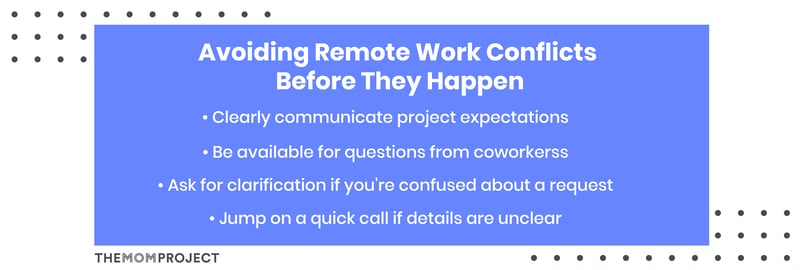Work conflicts are bound to arise, either because of a difference of opinion, work style, technique or even simply different personalities. A Myers-Briggs study found that 85% of employees experience conflict in the workplace to some degree and U.S. employees spend almost 3 hours a week on average dealing with some kind of conflict.
Unfortunately, many of the things that make remote work, well, work - flexible schedules and company support for online chat and project management software for example - also set the stage for misunderstandings and conflicts. With remote work becoming more common, it’s increasingly important to learn how to deal with these misunderstandings when you can’t meet face to face.
No one wants to dedicate time to unnecessary conflict. The good news? A few simple changes in your approach to scheduling your day, how you communicate expectations and the way you use email and chat can help minimize conflicts and help you resolve them quickly. Here’s how to resolve work conflicts remotely so you can continue to produce your best work.
Common causes of remote work conflicts
Conflict happens to everyone in the workplace. Conflicts with remote coworkers can be more difficult to resolve than normal because of the distance. Without the ability to communicate informally with each other throughout the day, it can be harder to feel “in sync” with your fellow employees. Being isolated in a work-from-home environment can make you feel unheard or unseen. These feelings can lead to anxiety and produce conflicts between you and other employees.

Ultimately, these conflicts make it hard to be productive and effective in your role, so it’s important to address them promptly. First, consider why you’re experiencing conflict. This can help you figure out your next steps. Conflicts in the remote workplace often occur because of:
ℹ️ Lack of information: When you’re working in an office environment, it’s easy to chat with team members and run through project details in person. Remote communication happens across email, online chats, project management software and message boards - often all for a single project. It’s easy to assume that people know what you mean or know what needs to be done, but it’s important to over-communicate and be specific when working remotely.
⏰ Response times: If you aren’t available to respond when teammates have questions, it can cause confusion and conflict. Flex schedules are helpful for remote workers because we can get our jobs done when it’s most convenient to our schedules, but this may not be the same schedule for others on our team. If you’re the subject matter expert or know that the rest of your team members will be working on a specific project and may need your input, plan to be more available on those days.
🔎 Lack of context: When you’re working with remote coworkers, written communication is the norm. Between email, chat programs and notifications, you’ll be typing the majority of your conversations. It’s easy for these conversations to be taken out of context because they exclude most of the non-verbal signals used in face-to-face communications. Remember, people read messages in their perceived tone of voice, which may be very different than the one you write the message with.
🖥️ Lack of accountability: People feel less inhibited about what they say online. Most of your work communications will be digital when you work remotely, so it’s easy to say things you may not normally say face to face.
3 steps to resolving work conflicts remotely
If you find yourself in a conflict, there are a few steps you can take to resolve it even if you’re working remotely.
1. Refocus
Workplace conflicts are often superficial and based on a difference of opinion. Recenter your focus on the task at hand and the common goal you share with your coworker. What is it that you’re both trying to accomplish for the company or the client? Remind yourself you have a common goal.
2. Reach out
Take the first step and reach out to the coworker you have a conflict with. Often, these conflicts are a simple misunderstanding of the overall timeline, who owns a task or the priority of a project. Keep it simple: apologize for any misunderstanding and clarify the need or idea you have in order to hit the common goal.
3. Resolve
Once you’ve figured out a resolution, look for ways to avoid the same conflict in the future. If the conflict arose because key details weren’t in the project brief, adjust the template moving forward. If there are too many people assigned to similar tasks (making it hard to accommodate everyone’s ideas), look for ways to divide and conquer the tasks.

When it’s time to reach out
Simple misunderstandings can often be cleared up over chat, while bigger issues may require an “in-person” conversation either over the phone or on Zoom.
When to Slack
Chat platforms are like text messages. They’re best for quick, simple questions that don’t require input from the rest of the team. It’s also great if you need an immediate, quick response. When it comes to conflict, Slack is a good way to clarify expectations or timelines.
When to email
If you need to provide more details in order to resolve a conflict, send an email. Email allows you to provide more context than a chat and provide additional links or copy/paste previous notes to clarify a misunderstanding. Using email is also a great way to track your conversation on a topic if you feel you’ll need to involve your manager or HR in the future.
When to set up a meeting
Setting up a meeting is great if there are a lot of different scenarios to walk through, like “if we do this, then we could do this or that." If you need to gather more details in order to determine your part in a conflict or to resolve it, it’s best to set up a video chat or phone call to talk things through.
When to escalate the conversation
If you’ve tried to resolve a conflict remotely without success, it’s time to involve your manager. Approach this conversation from a place of getting feedback on your approach, not tattling on your coworker. Let your manager know what led to the conflict, what steps you took to resolve it, and ask for their input on what you can do differently to resolve the issue.
Your manager may choose to reach out to your coworker directly, or may provide suggestions for you to follow. Either way, it’s a good thing to make them aware of the issue because it’s possible it’s more widespread than just between you and a coworker. There may be some processes that need to be adapted now that people are working remotely, for example.
Managing remote teams through conflict
As a manager, you’re managing the people on your team just as frequently as you’re managing their tasks. Overseeing this diversity of personalities and work styles can often feel like your full time role, especially if conflicts are common on your team.
If you feel like you’re spending a lot of time resolving conflicts between team members, here are some things to try.
🗣️ Model strong communication skills: If you notice conflicts happening because of a lack of information or misunderstandings of expectations, make sure you’re leading by example and clearly communicating details in one place. Create a project brief or plan a daily stand-up to make sure all details are communicated and all questions are answered. Creating these processes gives your team members a format to follow and allows them to begin to take more ownership of projects moving forward.
☑️ Schedule regular check-ins: A daily or weekly check-in meeting can be helpful in making remote employees feel like they’re all part of the same team. This also gives people the opportunity to ask quick questions or reset their priorities for the day so everyone is on the same page.
🔎 Set clear expectations: Make sure each project has a timeline and your team understands the deliverables they’re each responsible for. This can reduce missed milestones that delay other team members and lead to conflict.
⭐ Recognize good work: Either in your check-in meetings or in a monthly team meeting, take a few minutes to congratulate the team on work well done. Avoid singling out specific team members. Instead, reinforce a sense of unity by choosing one project that was well executed and calling out each team member’s specific contributions that made that success possible.
🔀 Switch things up: Don’t be afraid to shake things up if certain team members continue to have a conflict with each other or if some of your processes aren’t working. Consider your team’s time zones and work schedules, too, when reorganizing your team. It can be easier for people to work together when they’re in the same time zone or working during similar times of the day.
Working remotely doesn't have to mean an increase in conflicts
Working remotely is a change for many people. Some simple communication adjustments can make it easier to avoid work conflicts before they begin. Remember that you’re all on the same team with a common goal and reach out to resolve conflicts quickly before they escalate.
More and more of the workforce is going remote
Get access to job opportunities with vetted, family-friendly companies and learn how to successfully navigate remote work with The Mom Project. 



